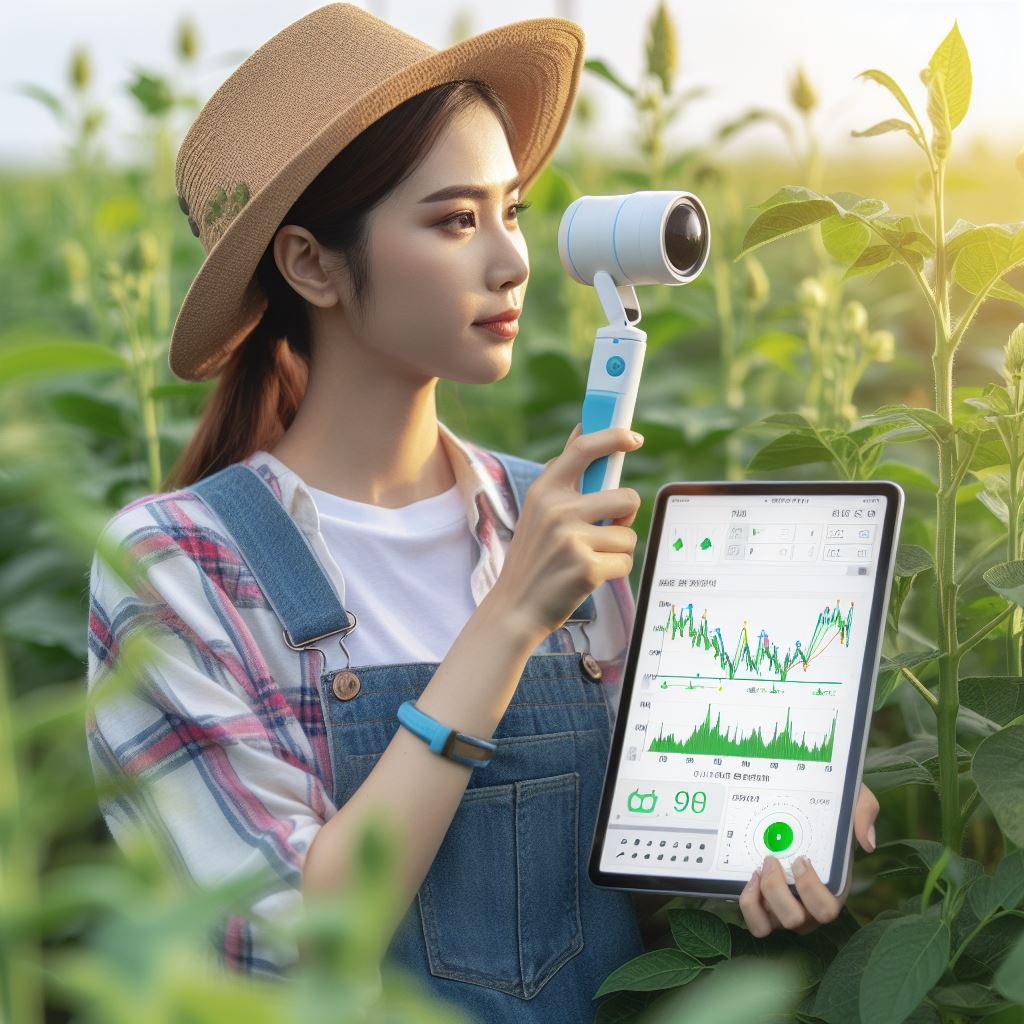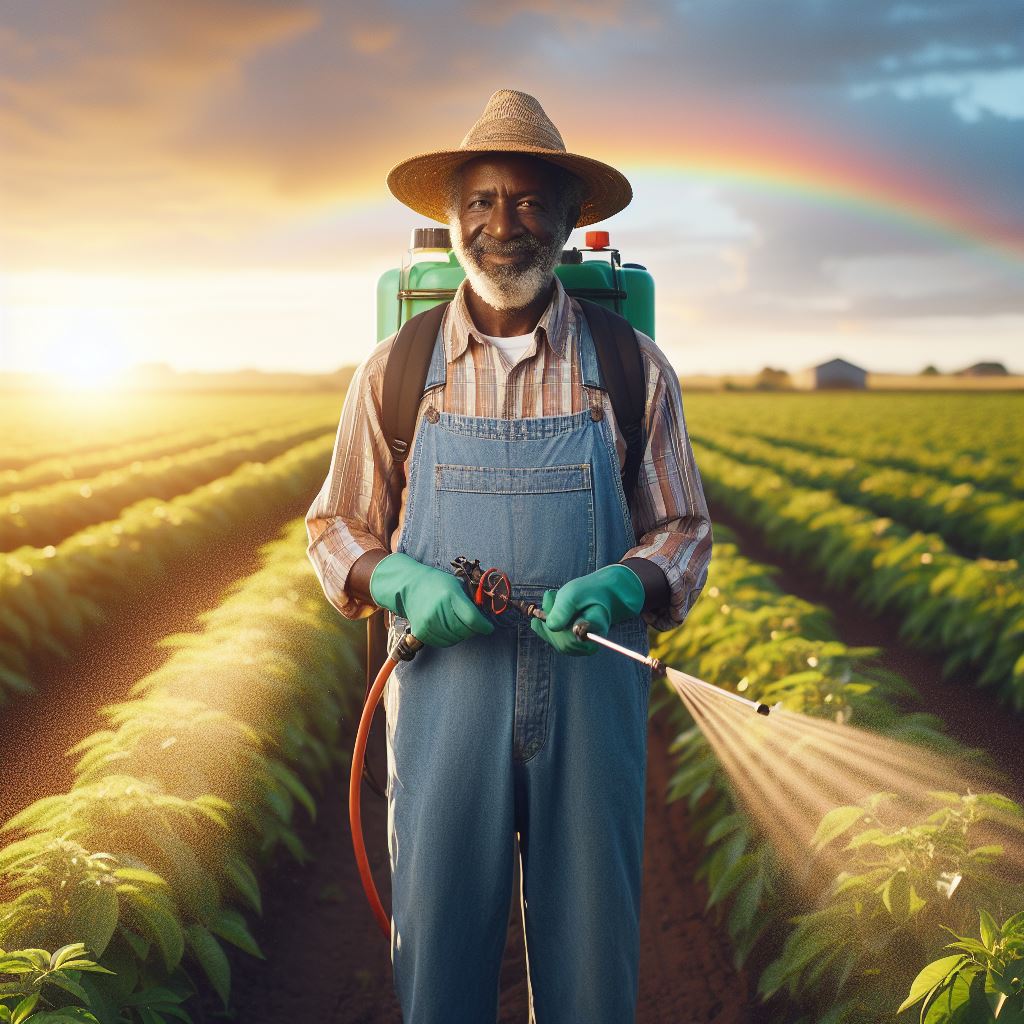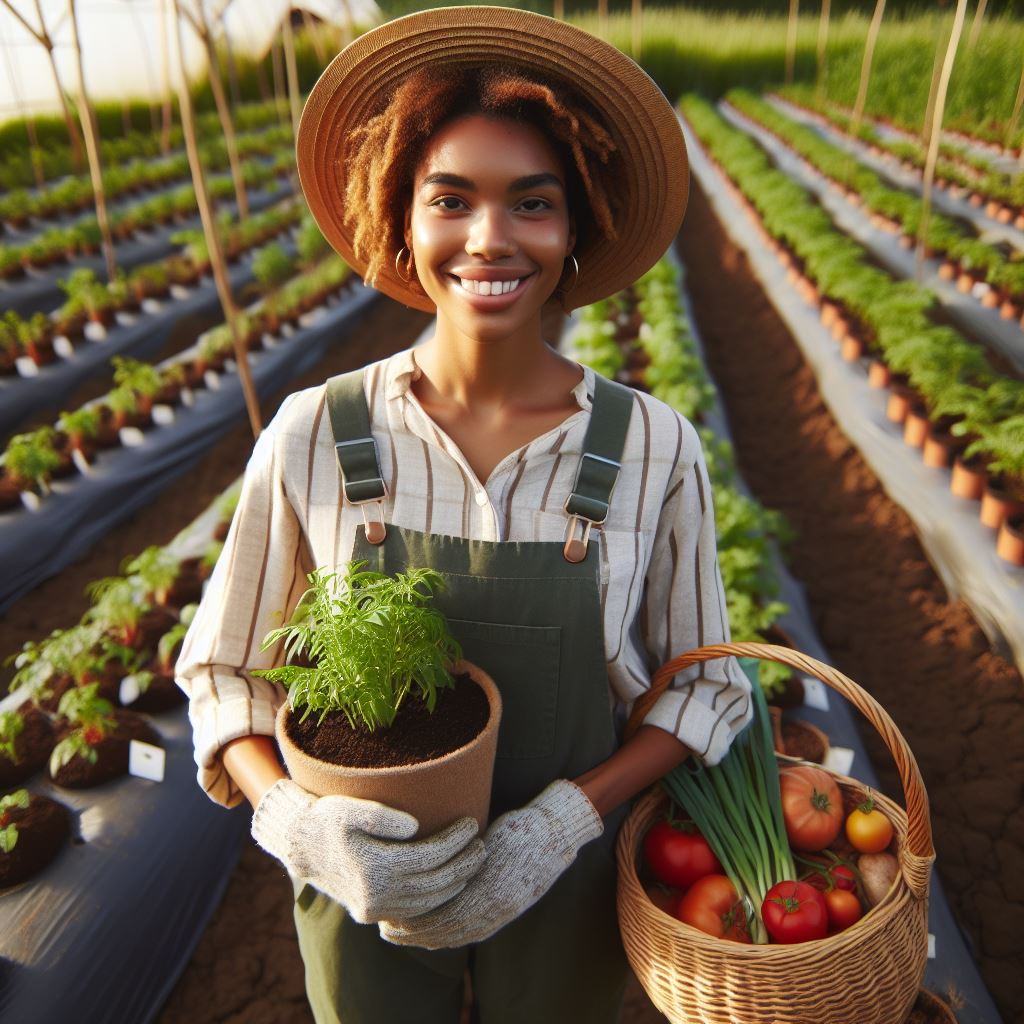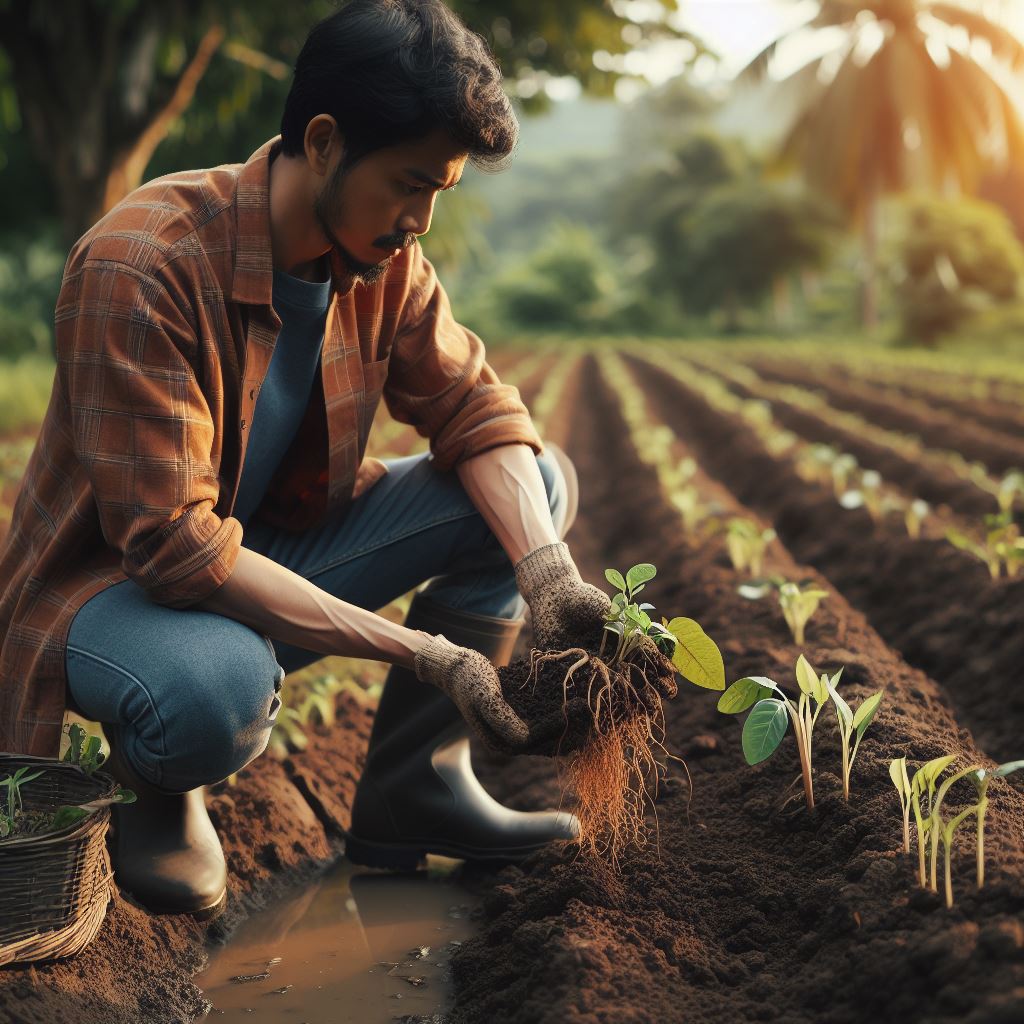Introduction
Crop Monitoring Importance
Efficient crop monitoring is crucial for optimizing agricultural yields and ensuring global food security.
The ability to access precise, real-time data on crop health, growth patterns, and environmental conditions empowers farmers to make informed decisions.
Technology in Crop Monitoring
In today’s agriculture landscape, technology plays a pivotal role in crop monitoring.
Advanced sensor technologies, such as drones, IoT devices, and satellite imagery, enable farmers to gather comprehensive data on various aspects of their fields.
These sensors provide real-time information on soil conditions, moisture levels, and the overall health of crops.
This guide delves into the transformative role of sensor technology in crop monitoring.
By exploring the applications, benefits, and future trends of these technologies, we aim to provide a comprehensive understanding of how they contribute to the evolution of smart farming practices.
Embracing these innovations allows farmers to optimize resource utilization, reduce environmental impact, and ultimately enhance overall crop productivity.
What is Sensor Technology
Definition of sensor technology
Sensor technology refers to the use of devices that collect data from the environment to measure specific parameters.
How sensors work in crop monitoring
Sensors in crop monitoring collect data on various aspects such as temperature, humidity, soil moisture, and light intensity.
They measure these parameters and transmit the data to a central system.
Types of sensors commonly used in agriculture
- Temperature Sensors: These sensors measure the temperature of the air, soil, or water.
- Humidity Sensors: Humidity sensors measure the amount of moisture present in the air or soil.
- Soil Moisture Sensors: These sensors determine the moisture content of the soil, helping farmers decide when to irrigate their crops.
- Light Sensors: Light sensors measure the intensity and duration of light, aiding in optimizing plant growth.
- Weather Sensors: These sensors monitor weather conditions such as rainfall, wind speed, and solar radiation.
- Leaf Wetness Sensors: Leaf wetness sensors detect the presence of moisture on plant leaves, helping prevent diseases.
- Gas Sensors: Gas sensors detect gas concentrations in the air, enabling farmers to monitor air quality and the presence of harmful gases.
These are just a few examples of sensors commonly used in crop monitoring.
Sensors are often combined to obtain more comprehensive data for efficient agricultural practices.
Benefits of Sensor Tech in Crop Monitoring
In crop monitoring, using sensor technology offers a wide range of benefits for farmers.
These benefits include:
Improved accuracy in data collection
Sensor technology allows for more precise and accurate data collection regarding various aspects of crop growth and health.
Traditional monitoring methods often rely on visual observation, which can be prone to human error and limitations.
With sensors, farmers can obtain real-time, quantitative data regarding soil moisture, temperature, nutrient levels, and more.
Real-time monitoring capabilities
The use of sensors in crop monitoring enables real-time monitoring capabilities, providing farmers with instant access to crucial information.
This allows them to quickly identify any issues or changes in crop conditions and take necessary actions promptly.
Real-time monitoring also facilitates early pest detection, preventing potential infestations and minimizing crop damage.
Enhanced decision-making for farmers
Sensor technology provides farmers with accurate and timely data, empowering them to make informed decisions regarding their crops.
By monitoring essential factors like soil moisture and nutrient levels, farmers can adjust their irrigation and fertilization strategies accordingly.
This leads to better resource allocation and increased crop yield.
Optimized resource management
With sensor-based crop monitoring, farmers can optimize resource management, minimizing waste and maximizing efficiency.
By precisely monitoring soil moisture levels, for instance, farmers can water their fields only when necessary, reducing water consumption and environmental impact.
Efficient resource management also extends to other areas such as pesticide application and energy usage.
In a nutshell, the application of sensor technology in crop monitoring brings numerous benefits to farmers.
It improves the accuracy of data collection, allowing for precise monitoring of various crop parameters.
Real-time monitoring capabilities enable prompt actions and early pest detection.
The availability of accurate data enhances decision-making, optimizing resource allocation.
Ultimately, using sensor technology leads to more efficient and sustainable crop management practices.
Types of Crop Monitoring Sensors
Soil sensors
In crop monitoring, different types of sensors play vital roles in gathering essential data for effective farming practices.
Soil sensors, for instance, detect and measure crucial parameters like moisture, temperature, and fertility levels.
By utilizing this technology, farmers can optimize irrigation and fertilizer application, resulting in improved crop yields and better resource management.
Weather sensors
Weather sensors are another important tool in crop monitoring.
These sensors provide real-time data on temperature, humidity, wind speed, and precipitation.
By monitoring weather conditions, farmers can make informed decisions about planting, disease prevention, and harvest timing.
Accurate weather data is crucial for ensuring crop health and maximizing productivity.
Crop imaging sensors
Crop imaging sensors are increasingly being utilized in modern agriculture.
These sensors employ advanced techniques such as hyperspectral imaging and thermal imaging to monitor crop health and growth.
By capturing detailed images of crops, early detection of diseases, nutrient deficiencies, and water stress becomes possible.
This allows farmers to take immediate action and prevent potential yield losses.
Transform Your Agribusiness
Unlock your farm's potential with expert advice tailored to your needs. Get actionable steps that drive real results.
Get StartedNutrient and moisture sensors
Nutrient and moisture sensors are essential for maintaining optimal growing conditions.
These sensors measure the levels of vital elements in the soil, such as nitrogen, phosphorus, potassium, and moisture content.
By accurately assessing nutrient availability and soil moisture, farmers can implement precision nutrient management strategies, reducing fertilizer waste and minimizing environmental impact.
Ultimately, this leads to improved crop quality and higher yields.
In closing, crop monitoring sensors are revolutionizing the field of agriculture.
Soil sensors provide valuable insights into soil conditions, enabling farmers to make informed decisions about irrigation and fertilization.
Weather sensors help farmers stay updated on weather conditions, aiding in disease prevention and harvest planning.
Crop imaging sensors allow for early disease detection and intervention, while nutrient and moisture sensors optimize nutrient management and conserve resources.
By utilizing these sensor technologies, farmers can enhance crop productivity, minimize resource wastage, and promote sustainable agriculture practices.
Read: Soil Testing 101: Key Steps & Benefits
Integration of Sensor Tech in Crop Management Systems
How sensors are incorporated into existing farming systems
Incorporating sensor technology into existing farming systems has become increasingly popular in recent years.
Farmers can benefit from precise data collected by sensors to optimize crop management and increase yields.
One way sensors are integrated is through wireless networks that transmit real-time data to a central monitoring system.
These networks allow farmers to remotely monitor various crop parameters such as soil moisture, temperature, and humidity.
Sensors can also be incorporated into farming equipment such as tractors and harvesters.
These sensors provide on-the-go measurements of soil conditions and crop health, allowing farmers to make immediate adjustments and optimize their operations.
Furthermore, farmers can install sensors directly in the field to monitor specific areas or individual plants.
These sensors can measure factors like nutrient levels, pest presence, and even the growth rate of crops.
Integration challenges and potential solutions
While the integration of sensors in crop management systems offers numerous benefits, there are also challenges that need to be overcome.
One challenge is the compatibility of sensors with existing farming infrastructure and equipment.
Different sensors use various communication protocols and technologies, making it difficult to ensure interoperability.
One potential solution is the standardization of communication protocols to facilitate seamless integration.
Another challenge is the power supply for sensors.
Many farms are located in remote areas without easy access to electricity.
To overcome this, solar-powered sensors can be used, reducing the dependency on external power sources.
Data management is also a challenge, as the amount of data generated by sensors can be overwhelming.
Implementing data analytics tools can help farmers make sense of this data and turn it into actionable insights for improved crop management.
Case studies of successful sensor integration in crop management
Several case studies demonstrate the successful integration of sensor technology in crop management.
In a study conducted in a vineyard, wireless soil moisture sensors were used to optimize irrigation practices.
By continuously monitoring soil moisture levels, the vineyard achieved water savings of 30% without compromising crop yield or quality.
Similarly, a potato farm integrated sensors into their planting equipment to measure soil fertility.
This allowed them to vary fertilizer application rates based on real-time soil nutrient data, resulting in a 20% reduction in fertilizer usage and improved crop quality.
Additionally, a citrus plantation used temperature and humidity sensors to monitor disease development.
Based on this data, they implemented targeted spraying and pest control measures, reducing pesticide usage by 40% while maintaining excellent crop health.
These case studies highlight the transformative potential of sensor integration in crop management.
As technology continues to advance, sensors will play an even more crucial role in optimizing farming practices and ensuring sustainable food production.
Read: Safe Use of Chemical Fertilizers in Farms

Learn More: Crop Disease Control: Organic Solutions
Considerations for Choosing Sensor Tech in Crop Monitoring
Cost implications of sensor technology
Choosing the right sensor technology for crop monitoring involves several important considerations.
One of the key factors to consider is the cost implications of the sensor technology.
Investing in sensor technology can be a significant expense, especially for smaller farms or farmers operating on a tight budget.
It is essential to weigh the cost of the sensor technology against the potential benefits it offers.
While advanced sensor technology may come with a higher price tag, it can provide more accurate and detailed data, leading to better decision-making and higher crop yields.
However, it is crucial to assess the return on investment and determine if the cost is justified for the specific farming operation.
Compatibility with existing farm infrastructure
Another crucial consideration when choosing sensor technology is its compatibility with existing farm infrastructure.
Before investing in any sensor technology, farmers need to evaluate their current equipment and systems.
They should ensure that the chosen sensor technology can seamlessly integrate with their existing infrastructure to avoid compatibility issues and additional costs.
For example, if a farm already has an irrigation system in place, it is essential to choose a sensor technology that can easily connect and communicate with the system.
This compatibility ensures efficient data collection and seamless integration of sensor technology into existing farming practices.
Showcase Your Farming Business
Publish your professional farming services profile on our blog for a one-time fee of $200 and reach a dedicated audience of farmers and agribusiness owners.
Publish Your ProfileEase of use and maintenance
Ease of use and maintenance are critical factors to evaluate when selecting sensor technology for crop monitoring.
Farmers need to consider the user-friendliness of the sensor technology and whether it requires specialized skills or knowledge to operate effectively.
The ease of installation and setup should also be taken into account.
Additionally, maintenance requirements should be considered.
Sensors should be durable and able to withstand harsh environmental conditions.
Farmers should assess the frequency and complexity of maintenance tasks associated with the sensor technology before making a decision.
Choosing a sensor technology that is easy to use and maintain can save time and effort, allowing farmers to focus on other crucial aspects of their operations.
Scalability for future needs
When selecting sensor technology for crop monitoring, it is important to consider scalability for future needs.
Farmers should assess whether the chosen sensor technology can expand or adapt to changing farming requirements.
It is crucial to choose a technology that offers flexibility and can accommodate future upgrades or additions.
For instance, if a farmer intends to expand their farming operation or incorporate new crops, the sensor technology should be able to accommodate these changes without significant modifications or replacements.
By considering scalability, farmers can future-proof their investments and ensure that the sensor technology remains relevant and effective in the long run.
In fact, choosing the right sensor technology for crop monitoring involves careful consideration of cost implications, compatibility with existing farm infrastructure, ease of use and maintenance, and scalability for future needs.
By evaluating these factors, farmers can make informed decisions and maximize the benefits of sensor technology in their farming operations.
Read: Innovative Farming in Changing Climates
Delve into the Subject: Tech Advances in Crop Planting
Potential Future Developments in Sensor Tech for Crop Monitoring
Emerging technologies and advancements on the horizon
- Improved drone technology could lead to more accurate and efficient crop surveillance.
- The integration of artificial intelligence and machine learning algorithms may enhance data analysis capabilities.
- Miniaturized sensors could be embedded within plants, providing real-time information on their health and nutrient requirements.
- Hyperspectral imaging, using sensors that capture a wide range of electromagnetic spectra, could enable early pest and disease detection.
- Wireless sensor networks could become more robust and widespread, enabling seamless monitoring across large farmlands.
Potential impact of new sensor tech on crop monitoring practices
- Enhanced accuracy: Advanced sensor technologies can provide more precise measurements, enabling farmers to make data-driven decisions.
- Increased efficiency: With real-time data collection and analysis, farmers can optimize resource allocation and reduce waste.
- Early detection of issues: New sensors can identify crop stress, diseases, or infestations before visible symptoms appear, allowing for timely interventions.
- Improved sustainability: By monitoring soil moisture, nutrient levels, and weather conditions, farmers can reduce water and fertilizer usage, minimizing environmental impact.
- Customized farming practices: Sensor data can facilitate personalized crop management strategies, tailored to each field’s specific needs, maximizing productivity.
- Risk mitigation: With continuous monitoring, farmers can respond swiftly to unforeseen factors such as extreme weather events or pest outbreaks, minimizing losses.
- Cost savings: By optimizing resource use and reducing crop losses, sensor technologies can result in significant cost savings for farmers.
- Increased scalability: Advanced sensor tech allows simultaneous monitoring of multiple fields, enabling larger-scale commercial agriculture operations.
- Global food security: With more efficient and productive farming practices enabled by sensor technologies, food production can meet the growing global demand.
- Innovation potential: As technology advances, the possibilities for sensor applications in crop monitoring are vast, opening up opportunities for further innovations.
In short, the future of sensor technology in crop monitoring holds immense promise.
Emerging technologies and advancements can revolutionize farming practices by providing accurate, real-time data and facilitating data-driven decision-making.
The potential impact of new sensor tech is far-reaching, from improving accuracy and efficiency to enabling early detection of crop issues and enhancing sustainability.
With the ongoing development of sensor tech, the future of agriculture looks brighter, promising increased productivity, reduced environmental impact, and enhanced food security.
Read: Organic vs Chemical Fertilizers: A Comparison
Conclusion
Recap of the importance and benefits of sensor technology in crop monitoring
Sensor technology plays a crucial role in crop monitoring, providing real-time data on various environmental factors.
It enables farmers to make informed decisions regarding irrigation, fertilization, and pest control, leading to improved crop yield and reduced costs.
Using sensors, farmers can closely monitor soil moisture, temperature, humidity, and nutrient levels, ensuring that the crops receive optimal conditions for growth.
This technology also helps detect early signs of disease or pest infestation, allowing for timely intervention and prevention of yield loss.
Furthermore, sensors enable remote monitoring, eliminating the need for manual data collection and reducing labor-intensive tasks.
Farmers can access data through mobile apps or online platforms, providing convenience and immediate insights into their crops’ health.
Final thoughts on the future of sensor tech in agriculture
The future of sensor technology in agriculture looks promising, with continuous advancements enhancing its capabilities.
As the demand for sustainable and efficient farming practices grows, sensor tech will play a crucial role in meeting these needs.
We can expect sensors to become smaller, more affordable, and more precise, making them accessible to farmers of all scales.
Integration with other technologies like artificial intelligence and automation will further revolutionize crop monitoring and decision-making processes.
In the future, sensor data will not only be used for monitoring crops but also for predictive analysis, enabling proactive measures to prevent crop loss and optimize resource utilization.
This will lead to more sustainable and environmentally friendly agricultural practices.
Overall, sensor technology has proven to be a game-changer in modern agriculture, revolutionizing crop monitoring and management.
Its benefits, including increased productivity, cost reduction, and sustainability, make it an indispensable tool for farmers around the world.
By embracing sensor tech and staying updated with future developments, farmers can maximize their yields, minimize risks, and contribute to a more sustainable and food-secure future.




